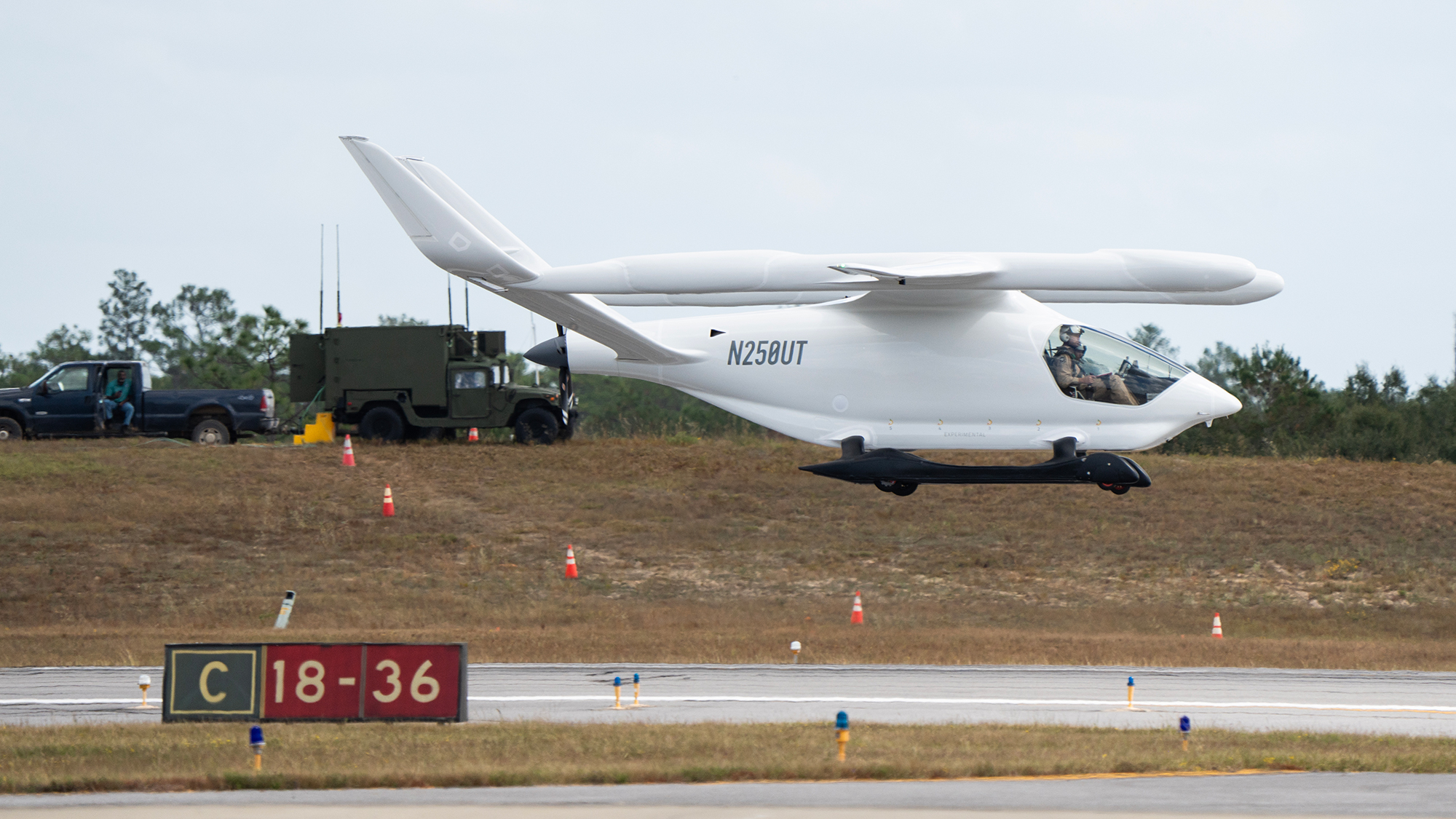

On Wednesday, October 18, an electric aircraft powered by a single propeller flew into, and then out of, Joint Base Andrews, the military facility famous for hosting Air Force One. That planned stop at the Maryland base was part of a long journey from Vermont to Florida.
Today, the aircraft, created by Vermont-based Beta Technologies, finally arrived in Florida, touching down at Duke Field airport, which is part of Eglin Air Force Base. The reason for the long trip from north to south is for Beta to give the US Air Force a chance to test the battery-powered aircraft and see how it handles tasks like moving cargo.
The testing the Air Force carries out will involve gathering “both ground and flight data,” says Maj. Riley Livermore, the flight commander for the 413th Flight Test Squadron. The exercises will involve “flying from point A to point B,” testing the plane at “different speeds,” simulating “different payloads,” and in general “seeing how the aircraft performs.” During these tests the aircraft will be crewed, meaning that it will be flown by a pilot who is on board the plane. The accouterments at Duke Field also include a Beta-installed charger to give the aircraft the juice it needs.

The aircraft, called Alia, has a 50-foot-long wing, seats for two pilots up front, and cargo space behind them. Beta is developing two different versions of the electric plane. One is called a CTOL aircraft, which stands for “conventional take-off and landing.” The aircraft that the Air Force will have on hand in Florida is outfitted for CTOL flight, meaning it takes off and lands by cruising down a runway, like a regular plane. A second version is designed for VTOL flight, an acronym that stands for “vertical take-off and landing.” That variant utilizes four propellers that are parallel to the ground to allow it to take off and land in that fashion. Both variants have a propeller in the back to push it through the air. Beta has a contract with UPS to eventually sell the package-carrier 10 planes, with an option for more, and also has a contract with United Therapeutics. The goal is to sell zero-emissions aircraft to companies that will use them for schlepping packages, cargo, and logistics.
[Related: Futuristic aircraft and robotic loaders dazzled at a Dallas tech summit]
Livermore says that having the aircraft for testing will allow them to compare how it stacks up against Alia’s “glossy brochure” in real-world use. “Actually doing it for months on end is gonna really give us good exposure to where it’s really strong, and where more development or investment is needed,” he adds. Part of that could involve monitoring how much it costs to charge up the aircraft’s batteries and keeping an eye on its maintenance needs.
The arrival of this electric aircraft at an Air Force base parallels a similar development that occurred in September, when Joby Aviation delivered their electric flying machine to Edwards Air Force Base in California. That VTOL aircraft from Joby will be flown in an uncrewed, remote fashion at first, and the Air Force says they might use the Joby aircraft for tasks like keeping an eye on the base’s perimeter. The Air Force, through a program called AFWERX and Agility Prime, will be testing out both the Beta aircraft in Florida and the Joby aircraft in California. “The data we’re generating here for Beta—that same kind of data is being collected for Joby” at Edwards, says Livermore, even if it’s not precisely an “apples-to-apples comparison.” Still, information regarding how long it takes to charge up a plane like this applies to both aircraft, as does answering questions about their ranges.
Beta and Joby are not the only two companies working on electric flight, to be sure. Other notable players in the new industry include Wisk, which is part of Boeing, and Archer, which just said it had flown its Midnight aircraft for the first time. Joby has also announced that it will build a large production facility to make its aircraft in Ohio, while Beta has opened a large production facility to do the same in Vermont. That Beta facility in Vermont measures 188,500 square feet—that’s about the size of 67 tennis courts—and has solar panels on the roof for power and geothermal wells for the climate system.

To get down to Florida, the Beta aircraft made more than a dozen stops along the way, departing Burlington, Vermont on October 11 and flying 84 miles to Glens Falls, New York, a hop that took 49 minutes. It eventually left New York, flying through states such as Massachusetts, Connecticut, Pennsylvania, Virginia, and the Carolinas, and finally ended up in Florida. The distance covered for the entire mission was 2,000 miles, according to Beta.
Several different pilots took turns operating it, including Nate Moyer, who has military experience flying aircraft such as F-16s. He was also the pilot at the controls for when the aircraft flew in and out of Joint Base Andrews. “The responsiveness is unbelievable,” he says, describing what it’s like to fly Alia. “It’s sensitive enough that I just kind of breathe on the stick and it does exactly what I want it to do.” In that sense it’s like the control stick for an F-16, which is also known for being very sensitive to pilot inputs.
Like a trip that this same Beta aircraft took last year out to Arkansas, this journey down south was a chance for regular people to see a neat new plane. “People come up and they ask really interesting questions that I never would have expected. We had a 5-year-old ask if we came from Mars,” Moyer mentions. “We didn’t actually remember to tell him ‘no,’ so I don’t know what he actually believes.”
